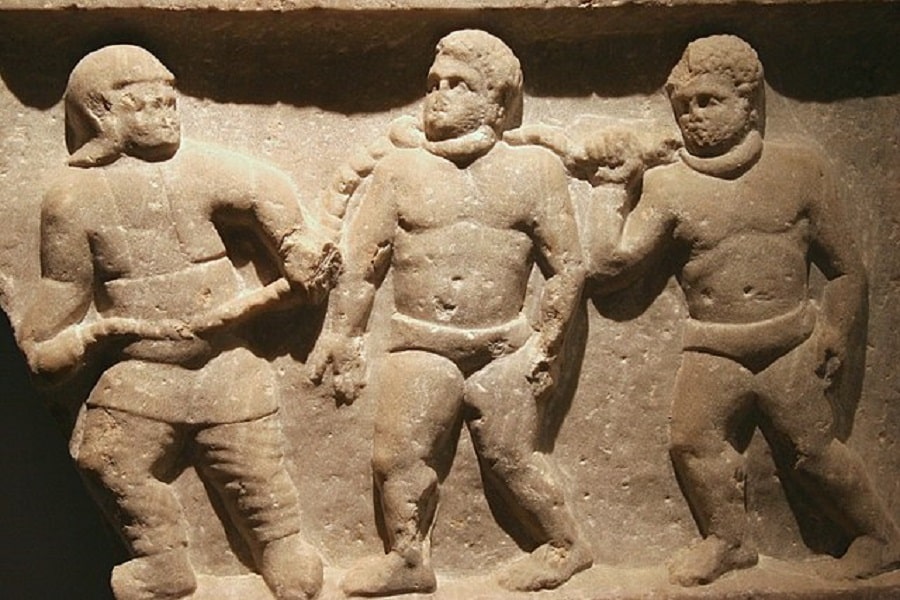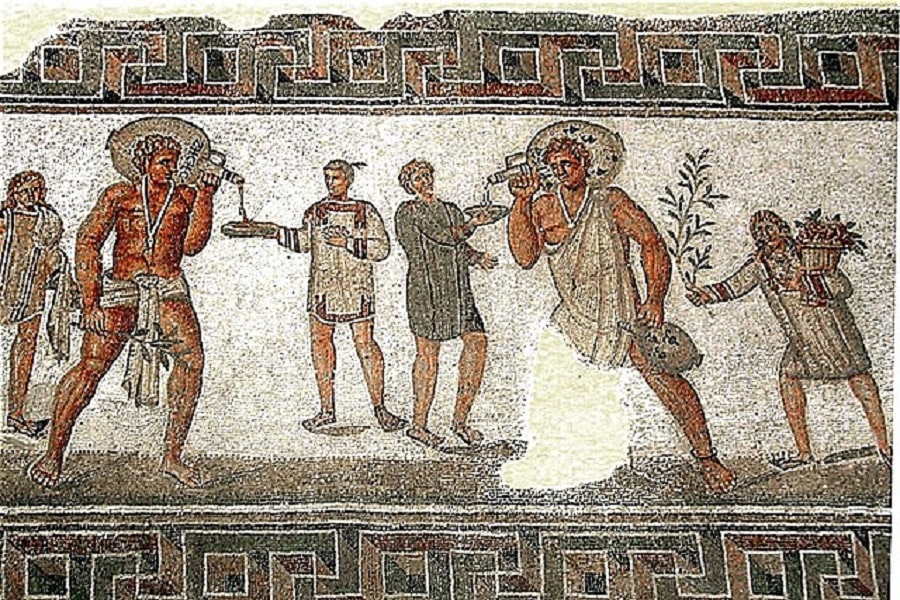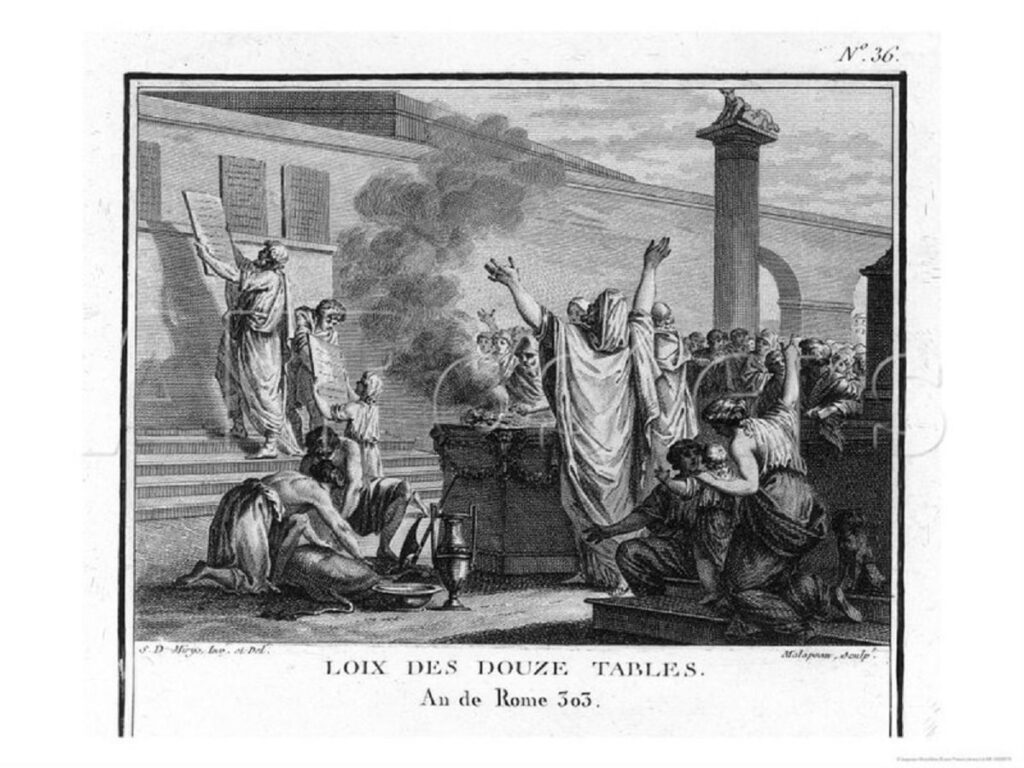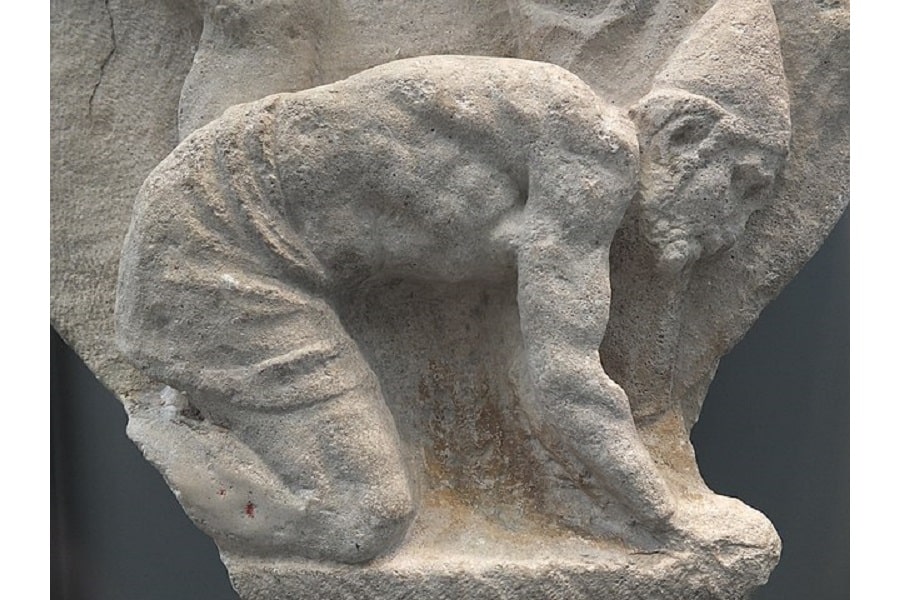Roman slaves were an ever-present and essential part of Roman society and its long history. Just as their functions in that society were multifarious – ranging from cooks, gardeners, builders, and gladiators – so were their regions of origin. Unlike in other periods of time, the race or ethnicity of slaves in ancient Rome was not a central part of their identity.
Table of Contents
Who Were Roman Slaves?

Roman slaves were known as “servi” or “servus” in Latin and were owned by other people and considered their property. Anyone could become a slave, and slaves in ancient Rome came from various sources, including war captives, debtors, criminals, and children born to slave parents.
Roman slaves performed a wide range of tasks and could be found in various settings, including households, agricultural estates, mines, workshops, etc. They worked as household servants, laborers, agricultural workers, tutors, nurses, and skilled craftsmen. Some slaves held high-ranking positions, such as secretaries or managers, while others endured backbreaking labor or were subjected to harsh conditions. This all depended on the owner of the slaves.
Slaves were considered property and didn’t have many rights. However, slaves could file complaints against severe mistreatment. They were not considered Roman citizens, but over time, some slaves were able to gain their freedom through various means and became Roman citizens and even gain wealth and influence in Roman society.
How Widespread Was Slavery in the Roman World?
Generally, slavery was very widespread across the Roman Empire and was an integral aspect of its very being. It has been argued that up to 30-40% of Italy’s population and 10-20% of the empire’s population were slaves at the height of Roman slavery.
As this shows, it was thought to have been most highly concentrated in Italy, followed by the wealthiest regions of the east (taking over from a long history of slavery in Classical Greece), as well as the most Romanized regions of Southern Spain, Southern Gaul, and North Africa.
As an institution, it seems to have been mostly limited to the elite, although some poorer citizens may have had the means to own some slaves as well. If they did, the remaining documentation does not offer us much insight.
Instead, we have an abundance of evidence – literary, archaeological, and epigraphical – that showcase the significance of slavery for the wealthy elite. In some cases, ownership of hundreds or even thousands of slaves is known through such documentary evidence.
For example, in the Annals of Tacitus (14: 43.4) the historian discusses how a particularly wealthy Roman has a retinue of 400 hundred slaves in Rome alone, distinct from the owner’s rural slaves.

How Important Were Slaves in the Roman World?
The widespread nature of slavery in the Roman empire and its long history in the Mediterranean world meant that slaves were an essential part of Roman life and the economy. As free peasants were often an important source of recruits for the Roman army, they could not be readily relied upon as a continual source of agricultural or domestic labor for the wealthy elite.
This explains in part why agricultural estates tended to be tilled and cultivated by groups of slaves so often in our sources. In these same sources, slaves also appear essential to the proper functioning of aristocratic households, filling the roles of cooks, cleaners, tutors, secretaries, and much more.
They also helped the state directly, by building public works, laboring in quarries and mines, and constituting a substantial portion of the emperor’s court bureaucracy. In this latter occupation, it is unclear how the Principate of the Roman Emperors could function at all without the large retinue of bureaucratic slaves it was known for.
Additionally, slaves filled another very important role in Roman society – as a marker of status for the wealthy elite. There is an interesting example in the account of the prosecution of the writer and philosopher Apuleius in 158 AD.
Because he only turned up with a couple of slaves, he was mocked by those present at the trial. As with slavery in other periods of time, the number of slaves one possessed, bestowed prestige and status on the owner.
How Did Roman Slavery Develop?
As an institution and trade, slavery appears to have been tied to the very foundation of Rome itself, as the mythical founder Romulus reportedly permitted new citizens to be able to sell their own children into slavery should they wish to do so.
It also appears to have been in general a part of ancient Mediterranean warfare that the conquered or defeated could be enslaved by their victors. Given that the Roman Republic and Empire were so famously and successfully expansionist, it makes sense that they would then accrue a considerable amount of enemy slaves.
The ownership of slaves is attested in the earliest forms of documented Roman Law – the Twelve Tables – and was to be regularly legislated on thereafter. Historians such as Strabo also report that Roman connections with the ancient slave trade were augmented each time it defeated or outlived a rival empire – especially the Seleucid Empire in the east.
As more slaves became integrated into the Roman economy, to man, build, and maintain ever larger estates, quarries, and public works, they became an increasingly essential element to Roman life and society.

What Functions Did Slaves Fill in Ancient Rome?
Slaves in ancient Rome could fill almost any function or occupation. With this being said, the evidence suggests the majority of them worked on agricultural estates, for wealthy Roman or provincial landowners, or as domestic workers for the aristocratic elite.
In these positions, the day-to-day labor for their owners, might vary quite widely, especially in domestic settings. On agricultural estates, many would till the soil and grow crops, which could be consumed or sold by their owners. Many might also work as herders, which seems to have been a relatively fortunate role for a slave.
Indeed, herders appear to have had more independence than usual agricultural slaves and were often able to form family units. This helps explain, in part, why many slave rebellions (discussed more below) seem to have been initiated by herders in the first place.
In the domestic sphere, slaves could fill very specialized roles for their master’s family. Whilst (mainly female) slaves could be nurses, cooks, and prostitutes, they could also fill roles such as secretaries, tutors, and accountants, for which they would receive quite considerable training.
As a result, the slaves filling these latter occupations would be advantaged in the event that their master freed them. Many slaves were not so lucky and might be used outside of these settings as work gangs in state quarries, which were notorious for their poor conditions.
Others might also be forced to fight in the arena, as gladiators (though these roles were not always filled by unwilling slaves). Another considerable portion of the slave population could be employed by the state with various jobs.
As mentioned above, the Roman emperors increasingly began to rely on a large body of bureaucratic slaves who could help administrate the empire for them. As with the educated slaves in domestic settings, these ex-bureaucrats often enjoyed a prosperous period of freedom after their “manumission.”

How Were Slaves Treated in Ancient Rome?
Perhaps surprisingly, the treatment of slaves in ancient Rome could vary quite significantly as well. Yet, it is important to first bear in mind that they were seen throughout the Roman world as property to be unwillingly bought, used, and sold with no consideration of the slave’s preference or opinion.
That being said, the sources present a rather mixed and conflicting picture which is not always so easy for historians to deal with. This is because of a number of reasons. One is that some of the remaining literature (esp. Pliny the Younger and Cicero) and epigraphy indicate quite close and friendly relations between slave and master, especially for those that were freed.
However, these would invariably have been domestic slaves, often the highly educated and valued ones. For the lesser slaves, whose roles seemed more expendable, we are often left in the dark about relations between slave and master and do not know how they were generally treated.
We do however have some portrayals of the horrific abuse that slaves suffered, in the works of writers like Juvenal and Seneca the Younger. Slaves could be randomly beaten or tortured, sometimes by professional “slave-floggers” and torturers. Moreover, they were deprived of almost all rights when compared with Roman citizens, although they still perhaps enjoyed more than later transatlantic slaves of the European empires.
For example, throughout the Roman Republic and Empire, an extensive body of legislation was passed that granted some protections to slaves. However, these laws – sometimes passed by the emperor himself – almost always framed slaves as property, which could not be stolen or destroyed.
Certain pieces of legislation, in the Digest and Code of Theodosius, did however attempt to rein in violent masters killing their own slaves. The emperor Hadrian passed legislation that forbade masters from throwing their slaves to wild beasts for public entertainment, just as Antoninus Pius attempted to curb excessive brutality towards slaves.
Eventually, this developed to the stage that killing a slave without sanction from a judge was declared a crime. However, these laws do demonstrate that masters had previously (and likely still did) kill their slaves in brutal ways, like “throwing them from a height,” “handing them over to fight wild beasts,” and “hanging them from a noose.”
Moreover, there were no regulations or restraints in place regarding what an owner could do with his slave sexually, at least if the owner was male. Whilst it was frowned upon in certain circles for aristocratic men to engage in sexual acts with male slaves (especially if they were passive participants), they were still very much permitted to do as they pleased.
Women on the other hand were not supposed to engage in such acts with slaves, although legislation passed throughout the Roman Republic and Empire (by Augustus, amongst others) suggested that it was relatively common for some to do so. Nonetheless, these restrictions were wholly influenced by patriarchal anxieties about the sexual “immorality” of women, engaging in intimate acts with socially inferior slaves.
In this vein, slaves were also seen as morally inferior as well and commentators often tried to justify the enslaved state through assumptions of their inner depravity and backwardness. These opinions proliferated throughout Roman literature and plays, with depictions of the “cunning slave” or stupid slave very prominent in domestic narratives.
Nonetheless, slaves were still usually paid in the Roman world, with a peculium. Although this was only a very modest salary it did allow the slave some freedom to purchase certain goods, just as it could be used to eventually buy their freedom. Moreover, many slaves appear to have been able to form family units and were not regularly chained up, as we see in later manifestations of slavery.
This does not mean however that their life was secure, or very free, especially on agricultural estates. On such estates, they were usually housed in barracks and kept in check by an overseer who may use brutal methods to keep them in check.
Additionally, the family units they might have formed could be easily broken up, with members sold to other estates or slavers, with no consideration for the slaves themselves.

Where Did the Roman Slaves Come From?
The Romans sourced their slaves in a variety of different ways. While there were very famous (and infamous) slave trading settlements and ports – for example at Delos in Greece – most Roman slaves are believed to have been born into slavery.
This meant that female slaves would possess unique value for a slave owner, as a producer of more slaves for the household or estate. Often these newborn slaves may have been the offspring of the master himself, although they would not legally be considered his kin. It is believed this was seen as a cheap and reliable form of continuous slaves, rather than relying on other sources.
These other sources included enemy captives whilst the Roman army was campaigning. In one instance, when the Greek city of Epirus was taken in 167 BC, 150,000 people were sold into slavery by the Roman state. However, as striking as this may be, such a scale of captive slaves was not the norm across the empire and the elite could not expect a continuous supply of slaves from Roman conquest.
Elsewhere, there was also a source of slaves from the “exposure” of children – who were left (usually in a known location) after they were born, or at a young age, because their parents did not think they could afford to raise them, or did not have the inclination to do so anyway. Opportunistic slave traders, or slaves working for the elite would regularly prowl these locations looking for new “stock.”
Roman citizens could also find themselves as slaves – either due to their inability to pay off their debts or by being illegally kidnapped by slavers somewhere in the empire. We know the latter practice was quite widespread across the frontier areas and was a constant concern to successive emperors and their administrations.
We also know that children were sometimes sold to patrons and wealthy neighbors as slaves if the family did not have the means to raise their children – particularly in times of economic difficulty.
Could Roman Slaves Obtain their Freedom?
One fact that is most surprising about Roman slavery, is that a considerable number of those enslaved were expected to receive their freedom (although they were still the minority). Unlike the institution of slavery in the Greek world, it was almost seen as conventional that many domestic and state slaves would one day be “manumitted.”
The term “manumission” signifies the “freeing/letting go” that was carried out by the owner, usually in the presence of a magistrate, who would free the slave by laying a rod (festuca) on the head of the slave.
Their manumission was brought about, either by the master’s favor – perhaps due to the close relationship they shared – or through the slave actually buying their own freedom. As mentioned above slaves were usually given a small wage, known as a peculium, throughout their term of service, which could later be used to buy their freedom.
The freed slave, subsequently to be known as a “freedman” or “freedwoman” (libertus/a), was granted a cap of liberty known as “pileus”, along with documentation attesting to their new freedom. Whilst these were supposed to assure their perpetual freedom, some freedmen were re-enslaved by rapacious magistrates or officials.
Nonetheless, the process of manumission granted ex-slaves their citizenship and allowed them to engage in business ventures, much in the same way they had when they were owned by their masters.
Now, however, they were able to accrue considerable wealth, although they were often despised for doing so. A notorious example is Pallas, a freedman of the emperor Claudius, who garnered the ire of contemporaries like Tacitus and Pliny the Elder for the wealth he accumulated.
Yet, liberti were strongly expected to still serve their ex-master in a number of ways as their client. They were expected to show obsequium – obedience, and reverence – to their ex-master always and were also to carry out work (operae) for their master when it was requested.
They could not hold political office, nor could they marry citizens of senatorial status (though they could marry other citizens after 18 BC). These restrictions were often accompanied by distrust and prejudice against liberti, who were still seen as socially inferior, particularly when they attempted to rise above their station after manumission.
This negative attitude towards them was very pervasive during the Roman empire making them objects of mistrust of suspicion when they were close to emperors or other powerful personages. As discussed above they were also disparaged in all forms of literature, especially in plays like the Satyricon, where the protagonist freedman Trimalchio is presented as a gaudy upstart, overindulging in luxury.
It is also important to remember that many Roman slaves were unlikely to ever receive manumission, particularly because the price or conditions for liberation were often determined by the owner. Moreover, many of the slaves working in the harshest roles throughout the empire would not have lived long enough to receive their freedom.

Slave Rebellions and Resistance
Whilst some Roman slaves could someday hope for their eventual freedom, this did not mean that the history of Roman slavery was not littered with examples of resistance and rebellion. As early as 198 BC, the Roman historian Livy documents a serious slave rebellion in Italy that was followed by another, two years later.
These were followed slightly later by rebellions in Sicily (and others in Italy) that developed almost into breakaway revolts which had to be put down by Roman armies. These “Servile Wars” as they came to be known sometimes involved tens of thousands of slaves that wreaked havoc across the countryside.
The last of the Servile Wars was spearheaded by the famous gladiator slave Spartacus, which directly threatened the Italian heartland of Rome. Eventually, around 120,000 men, women, and children had been amassed, although they were ultimately defeated in 71 BC and 6,000 were infamously crucified along the Appian way which led into Rome.
After this, slave rebellions do seem to have decreased significantly, as authorities took measures to mitigate the chances of them happening again. Nonetheless, they demonstrate that life as a slave was sufficiently oppressive and difficult to embolden individuals into taking on the Roman state.
In this vein, there seems to have been a general feeling of unease and anxiety amongst Roman slave owners about their slaves. The legislation was passed that enabled slaves to be tortured if they were within close proximity to their master when they died, especially if the death seemed suspicious.
This, therefore, indicated that slaves may have occasionally killed their masters as well, perhaps if they were treated particularly badly. Yet slaves could also try to resist in nonviolent ways as well, such as running away.
From legislation and scattered anecdotes, it seems as though runaway slaves were quite a common feature of Roman cities and the countryside. Rewards would be put up for the capture and return of slaves who could be badly beaten for their transgression. Whilst some on the frontiers could perhaps have escaped, it would have been much harder for slaves in the empire’s heartland of Italy.

Where Can We Learn about Roman Slaves?
Since slaves were so prevalent in Roman society, it is no surprise that they are often mentioned by contemporary writers. Whilst these sources are useful for giving a glimpse into the occupations and lives of ancient Roman slaves, they are of course written invariably by the slave-owning elite of the Roman world.
Fortunately, however, we do have an abundance of funerary inscriptions set up by ex-slaves themselves who had received manumission from their masters. These go someway in providing a first-hand glimpse into the lives of Roman slaves, although they only reflect the lives of those who were lucky enough to receive manumission.
Writers like Cato and Columella describe the use of slaves carrying out agricultural and horticultural work quite extensively. In these works, the primary focus is on tending a garden or managing an estate, but naturally, this means that the slave workforce is often discussed in some detail.
Similarly, writers like Pliny the Younger, Cicero, and Aulus Gellius, when discussing domestic life, often provide glimpses of the day-to-day occupations of slaves in the house. Roman law and legislation also help to substantiate our understanding of Roman slavery as it documents the legal and economic position of slaves in daily life.
As discussed above, we are also provided with perspectives and portrayals of Roman slaves from Roman drama, comedy, and philosophy. Whilst Seneca laments the lot of slaves in the Roman world, Juvenal seems to laugh at their anguish and suffering.
Collectively then, we are fortunate to have a considerable diversity of different sources to consult when looking at Roman slavery. They of course have their limits, but they help us to get an understanding of where slaves fit into the Roman world. They show us that Roman slavery was clearly an oppressive (and often brutal) condition, but also a truly unique institution that could sometimes be a vehicle for social elevation.